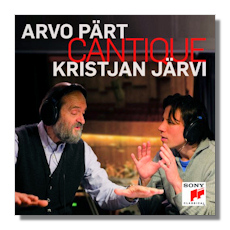
The Internet's Premier Classical Music Source
Related Links
- Pärt Reviews
- Latest Reviews
- More Reviews
-
By Composer
-
Collections
DVD & Blu-ray
Books
Concert Reviews
Articles/Interviews
Software
Audio
Search Amazon
Recommended Links
Site News
 SACD Review
SACD Review
Arvo Pärt

Cantique
- Stabat Mater for Choir & String Orchestra (27:59)
- Symphony #3 (24:01)
- Cantique des degrès for Choir & Orchestra (7:47)
RIAS Kammerchor
Berlin Radio Symphony/Kristjan Järvi
Sony 88697-75391-2 Hybrid Multichannel SACD
This CD contains three works, only the last and shortest of which, the nearly eight-minute Cantique des degrés, being directly related to the album's title, Cantique. Arvo Pärt, for those unfamiliar with his music, created a style which he called tintinnabuli, a sort of musical parallel to the "tintinnabulation" in Edgar Allan Poe's poem, The Bells, which, coincidentally Rachmaninov set to music in his choral masterwork of the same title. Pärt's tintinnabuli style exhibits a minimalist-like character, employing music derived from an inversion of a particular chord and creating bell-like sounds, which impart various overtones to yield or evolve related sound patterns. That kind of explanation can sound a little confusing, and so some musicologists have simplified things, calling his music "holy minimalism".
The leadoff work on the CD, the Stabat Mater for Choir and String Orchestra (2008), is a revised version of Pärt's Stabat Mater for soprano, countertenor (or alto), tenor and string trio. The composer wrote it on commission from the Tonkünstler-Orchester, whose offer to him was made at the behest of its principal conductor, Kristjan Järvi. It is a lovely work of great serenity: when the chorus isn't singing soothing heavenly music, the strings seem to be; and there is a sense throughout of the music transpiring in slow motion, as if a religious mesmerism is permeating the proceedings. In the end, one doesn't hear the music as part of the tintinnabuli method or as the product of a system of composition, but rather as lovely, simple music whose magnetic appeal is undeniable.
The closing piece here, Cantique des degrés for Choir and Orchestra, was written in 1999 on commission from Princess Caroline of Monaco. Revised in 2002 and having a text based on Psalm 121 ("I will lift up mine eyes…"), it is a livelier and more colorful work than the Stabat Mater, not least because one catches a whiff of Brahms and Elgar in places. It strikes one as a sort of beautiful hodgepodge that also evokes a sense of serenity, though a more earth-bound variety. These are première recordings of the revised Stabat Mater and the Cantique des degrés, and I can happily report that young Kristjan Järvi draws fine performances from both the orchestra and chorus. I doubt anyone will offer a better performance of either in the near future.
Pärt's 1971 Symphony #3 was written before the composer had worked out his tintinnabuli method and thus is largely free of the style. I have two other recordings of the piece, one on DG by Kristjan Järvi's father, Neeme, who conducts the Gothenburg Symphony Orchestra, and the other on Naxos by Takuo Yuasa, leading the Ulster Orchestra. There have also been several other recordings of the work, including one by Kristjan's brother, Paavo. For a contemporary work to enjoy such currency is rare and thus speaks well of its reputation and ultimately of its artistic status. It is an austere symphony, far less mellifluous than the other works on this disc, but a worthwhile piece nonetheless. It has a medieval feel, with the air of Gregorian chant and of religious fervor. Based entirely on three motifs, it is a mystical three-movement tonal work whose icy demeanor reveals a measure of warmth beneath the surface, especially in the slow second panel.
I like Yuasa's faster tempos in this symphony, which yield a total time of 20:22. But I must confess that Kristjan and his father, who are both similar in their tempo choices (25:17 for Neeme and 24:01 for Kristjan), are probably closer to the composer's intentions. I should mention that Pärt is a lifelong friend of the Järvi family, and was apparently present during Kristjan Järvi's recording sessions, thus giving this disc a good measure of authenticity, or, dare I say, stamp of approval? Neeme Järvi offers a somewhat muscular and epic approach in his recording, while Kristjan points up the mystical side of the work, not sanding the rough edges so much as treading lightly and carefully across them. His performance is somewhat scaled down sonically: it appears to be recorded at a slightly lower level and perhaps from a more distant perspective. Those same sonic properties hold true for the other works as well, and thus serve the music's mystical and religious character quite effectively.
Overall, this disc must be judged a must for Pärt's many admirers, as well as for those interested in contemporary music. Minimalist and chant aficionados would likely also find this music to their liking.
Copyright © 2010, Robert Cummings





















